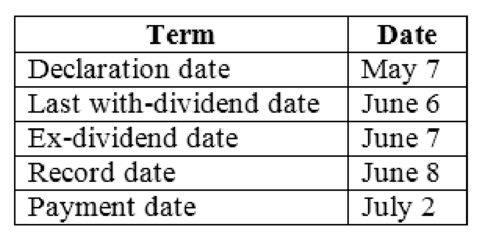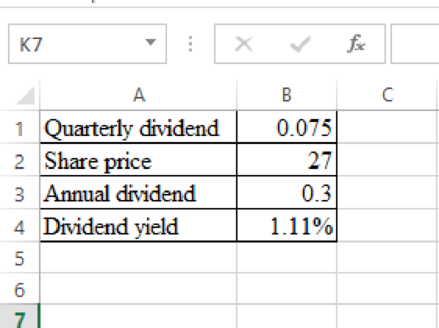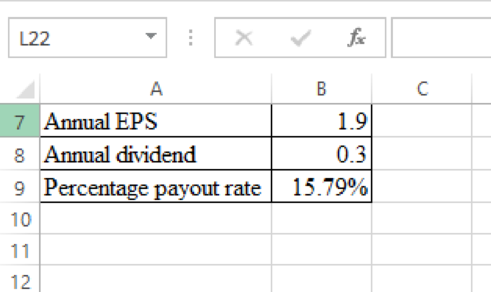
BARUCH FUND OF CORPORATE FIN. W/CONNECT
10th Edition
ISBN: 9781264531820
Author: BREALEY
Publisher: MCG CUSTOM
expand_more
expand_more
format_list_bulleted
Question
Chapter 17, Problem 1QP
a)
Summary Introduction
To determine: The correct date for each terms.
a)
Expert Solution
Explanation of Solution
Matching table:

b)
Summary Introduction
To determine: The date at which one of the stock price likely to fall by about the amount of the yield.
b)
Expert Solution
Explanation of Solution
The share cost is relied upon to fall on June 7, the ex-dividend date. The value falls on this day in light of the fact that, as the share goes ex-profit, the share proprietors are not, at this point qualified to gather the profit payable on July 2.
c)
Summary Introduction
To determine: The prospective dividend yield.
c)
Expert Solution
Explanation of Solution
Computation of dividend yield:

Hence, the prospective dividend yield is 1.11%.
d)
Summary Introduction
To determine: The percentage pay-out ratio.
d)
Expert Solution
Explanation of Solution
Computation of percentage pay-out ratio:

Hence, the percentage pay-out ratio is 15.79%.
Want to see more full solutions like this?
Subscribe now to access step-by-step solutions to millions of textbook problems written by subject matter experts!
Students have asked these similar questions
4. On August 20, Mr. and Mrs. Cleaver decided to buy a property from Mr. and Mrs. Ward for
$105,000. On August 30, Mr. and Mrs. Cleaver obtained a loan commitment from OKAY
National Bank for an $84,000 conventional loan at 5 percent for 30 years. The lender informs
Mr. and Mrs. Cleaver that a $2,100 loan origination fee will be required to obtain the loan. The
loan closing is to take place September 22. In addition, escrow accounts will be required for all
prorated property taxes and hazard insurance; however, no mortgage insurance is necessary. The
buyer will also pay a full year's premium for hazard insurance to Rock of Gibraltar Insurance
Company. A breakdown of expected settlement costs, provided by OKAY National Bank when
Mr. and Mrs. Cleaver inspect the uniform settlement statement as required under RESPA on
September 21, is as follows:
I. Transactions between buyer-borrower and third parties:
a. Recording fees--mortgage
b. Real estate transfer tax
c. Recording fees/document…
Hello tutor give correct answer
Need assistance urgently by the expert.
Fake answers will be rate as unhelpful.
Chapter 17 Solutions
BARUCH FUND OF CORPORATE FIN. W/CONNECT
Ch. 17 - Prob. 1QPCh. 17 - Prob. 2QPCh. 17 - Prob. 3QPCh. 17 - Prob. 4QPCh. 17 - Prob. 5QPCh. 17 - Prob. 6QPCh. 17 - Prob. 7QPCh. 17 - Prob. 8QPCh. 17 - Prob. 9QPCh. 17 - Prob. 10QP
Ch. 17 - Prob. 11QPCh. 17 - Prob. 12QPCh. 17 - Prob. 13QPCh. 17 - Prob. 14QPCh. 17 - Prob. 15QPCh. 17 - Prob. 16QPCh. 17 - Prob. 17QPCh. 17 - Prob. 18QPCh. 17 - Prob. 19QPCh. 17 - Prob. 20QPCh. 17 - Prob. 21QPCh. 17 - Prob. 22QPCh. 17 - Prob. 23QPCh. 17 - Prob. 24QPCh. 17 - Prob. 26QPCh. 17 - Prob. 27QPCh. 17 - Prob. 28QPCh. 17 - Prob. 29QPCh. 17 - Prob. 30QPCh. 17 - Prob. 31QP
Knowledge Booster
Similar questions
- please don't use ai and if you cant understand given values please don't answer question otherwise unhelpful will be given.arrow_forwardfinance subjectarrow_forwardCould you help explain, what is the complete salary survey analysis, and ensuring the data is relevant and up-to-date? What is the job evaluation and compensation plan? How to ensure the final report is comprehensive, clearly structured, and aligned with the company vision?arrow_forward
- The maturity value of an $35,000 non-interest-bearing, simple discount 4%, 120-day note is:arrow_forwardCarl Sonntag wanted to compare what proceeds he would receive with a simple interest note versus a simple discount note. Both had the same terms: $18,905 at 10% for 4 years. Use ordinary interest as needed. Calculate the simple interest note proceeds. Calculate the simple discount note proceeds.arrow_forwardWhat you're solving for Solving for maturity value, discount period, bank discount, and proceeds of a note. What's given in the problem Face value: $55300 Rate of interest: 10% Length of note: 95 days Date of note: August 23rd Date note discounted: September 18th Bank discount rate:9 percentarrow_forward
arrow_back_ios
SEE MORE QUESTIONS
arrow_forward_ios
Recommended textbooks for you
 Essentials Of InvestmentsFinanceISBN:9781260013924Author:Bodie, Zvi, Kane, Alex, MARCUS, Alan J.Publisher:Mcgraw-hill Education,
Essentials Of InvestmentsFinanceISBN:9781260013924Author:Bodie, Zvi, Kane, Alex, MARCUS, Alan J.Publisher:Mcgraw-hill Education,

 Foundations Of FinanceFinanceISBN:9780134897264Author:KEOWN, Arthur J., Martin, John D., PETTY, J. WilliamPublisher:Pearson,
Foundations Of FinanceFinanceISBN:9780134897264Author:KEOWN, Arthur J., Martin, John D., PETTY, J. WilliamPublisher:Pearson, Fundamentals of Financial Management (MindTap Cou...FinanceISBN:9781337395250Author:Eugene F. Brigham, Joel F. HoustonPublisher:Cengage Learning
Fundamentals of Financial Management (MindTap Cou...FinanceISBN:9781337395250Author:Eugene F. Brigham, Joel F. HoustonPublisher:Cengage Learning Corporate Finance (The Mcgraw-hill/Irwin Series i...FinanceISBN:9780077861759Author:Stephen A. Ross Franco Modigliani Professor of Financial Economics Professor, Randolph W Westerfield Robert R. Dockson Deans Chair in Bus. Admin., Jeffrey Jaffe, Bradford D Jordan ProfessorPublisher:McGraw-Hill Education
Corporate Finance (The Mcgraw-hill/Irwin Series i...FinanceISBN:9780077861759Author:Stephen A. Ross Franco Modigliani Professor of Financial Economics Professor, Randolph W Westerfield Robert R. Dockson Deans Chair in Bus. Admin., Jeffrey Jaffe, Bradford D Jordan ProfessorPublisher:McGraw-Hill Education

Essentials Of Investments
Finance
ISBN:9781260013924
Author:Bodie, Zvi, Kane, Alex, MARCUS, Alan J.
Publisher:Mcgraw-hill Education,



Foundations Of Finance
Finance
ISBN:9780134897264
Author:KEOWN, Arthur J., Martin, John D., PETTY, J. William
Publisher:Pearson,

Fundamentals of Financial Management (MindTap Cou...
Finance
ISBN:9781337395250
Author:Eugene F. Brigham, Joel F. Houston
Publisher:Cengage Learning

Corporate Finance (The Mcgraw-hill/Irwin Series i...
Finance
ISBN:9780077861759
Author:Stephen A. Ross Franco Modigliani Professor of Financial Economics Professor, Randolph W Westerfield Robert R. Dockson Deans Chair in Bus. Admin., Jeffrey Jaffe, Bradford D Jordan Professor
Publisher:McGraw-Hill Education